| Pages:
1
2
3
4 |
sbreheny
Hazard to Others
  
Posts: 145
Registered: 30-1-2014
Member Is Offline
Mood: No Mood
|
|
The crystals (which should be Thulium sulfate) look white to me. There is an intensely green tiny crystal in the magnified image but that crystal is
actually iridescent and fairly transparent. For scale, the piece of metal is about 0.75 inch long. The crystals unmagnified cover an area of about 1
inch by 0.75 inch. The magnification is roughly 80x in the magnified image.
|
|
|
IrC
International Hazard
    
Posts: 2710
Registered: 7-3-2005
Location: Eureka
Member Is Offline
Mood: Discovering
|
|
Your image of the raw metal looks like the piece of Thulium metal I'm holding right now. One question is, you keep mentioning concentrated acid (and
boiling off the solution) yet wiki clearly mentioned using dilute acid? Could this be why you are having different results?
"Science is the belief in the ignorance of the experts" Richard Feynman
|
|
|
sbreheny
Hazard to Others
  
Posts: 145
Registered: 30-1-2014
Member Is Offline
Mood: No Mood
|
|
The first time I dissolved a piece in acid, I used some acid from a bottle which I had pre-diluted a while ago to 1 M. I used technical grade 98%
H2SO4 and diluted it with distilled water.
Because someone mentioned the possibility of contamination of the acid, I remembered that I also had a bottle of 98% ACS reagent-grade H2SO4. So, for
the second try, I put a small piece of the metal in a test tube and added about 3mL of distilled water. I then added a few drops of the ACS
reagent-grade 98% H2SO4. I would say that I ended up with probably a 20% acid concentration - a bit stronger than the first time but still not
terribly strong.
I also mentioned strong acid because, as I was removing the water to recover the crystals of the supposed Thulium sulfate, of course, the remaining
acid became more and more concentrated until it would no longer evaporate at the temperature it was at (maybe 80 or 90C), so I increased the
temperature considerably (to maybe 250 or 300C) and it dried almost completely in short order, but produced a small cloud of very irritating vapor,
which I believe was h2so4 vapor.
|
|
|
Pok
potassium Prometheus
  
Posts: 176
Registered: 5-12-2010
Member Is Offline
|
|
Many rare earth metals can look like your sample. The fact that IrC's thulium looks the same, doesn't prove anything. It's just a hint, that it could
be thulium.
The crystals don't look like thulium sulfate octahydrate at all! They should be clear (!) and greenish. If you prepared them by boiling off the
concentrated acid, you will propably get anhydrous thulium sulfate. And I doubt that this compound is greenish (many anhydrous salts look
totally different compared to the hydrates)! Just dissolve the crystals in a minimum amount of water and let the water evaporate slowly at room
temperature. The crystals obtained in this way will be the octahydrate which looks greenish. In general, faint colours of crystals are only easy to
observe, if you have a larger amount of them. If you only have tiny amount, the characteristic colour is difficult to see!
BTW: using metallic Tm as a starting material is not the best way. First, high purity RE metals are much more difficult to produce than the oxides
(very high purities available). Second, the metals are usually more expensive than the oxides (molar mass difference included in this calculation).
|
|
|
sbreheny
Hazard to Others
  
Posts: 145
Registered: 30-1-2014
Member Is Offline
Mood: No Mood
|
|
Thanks, Pok. Unfortunately, the whole point of this exercise is to see if my sample is Thulium and I don't want to sacrifice the entire thing to get a
lot of the sulfate. I did re-dissolve the crystals in a small amount of water and left it sitting in air - I'll take another photo of the crystals
when they form again. I had to find a place to put this where my inquisitive and acrobatic cat would not be able to get to it 
I hope I'll be able to see the subtle color with magnification and proper light.
I checked the pH of the new solution (crystals re-dissolved in a small amount of water) and it was about 3 - so there is still a tiny amount of acid
left but not that much - looks like I did get rid of the vast majority of it.
|
|
|
sbreheny
Hazard to Others
  
Posts: 145
Registered: 30-1-2014
Member Is Offline
Mood: No Mood
|
|
I also did try to burn a small amount of the raw metal. I used a MAP-Pro (propylene gas) torch because it was handy. It glowed a bright orange but no
flame. Maybe once again the surface area is not high enough? Examination under magnification after trying to burn it showed a black layer (carbon?)
had formed on the surface but there were a few spots where white crystals emerged from the edges - possibly some of the oxide?
|
|
|
Brain&Force
Hazard to Lanthanides
    
Posts: 1302
Registered: 13-11-2013
Location: UW-Madison
Member Is Offline
Mood: Incommensurately modulated
|
|
No flame? That's really weird. Rare earths tend to burn really easily.
I'm an international hazard now! (just noticed that)
[Edited on 30.6.2014 by Brain&Force]
At the end of the day, simulating atoms doesn't beat working with the real things...
|
|
|
sbreheny
Hazard to Others
  
Posts: 145
Registered: 30-1-2014
Member Is Offline
Mood: No Mood
|
|
Well, this link says that it is "not flammable in ingot form", only in dust or thin foils:
http://www.espimetals.com/index.php/msds/288-thulium
I would hardly call mine an ingot but it is definitely thicker than a foil.
|
|
|
Brain&Force
Hazard to Lanthanides
    
Posts: 1302
Registered: 13-11-2013
Location: UW-Madison
Member Is Offline
Mood: Incommensurately modulated
|
|
Well, neither is magnesium, in that sense: you'll need minutes of continuous direct torching to light them in ingot form. They need tremendous amounts
of energy to ignite.
I've had success in taking tiny shards of terbium (3 - 5mm long × 1 mm across) and dropping them directly into a Bunsen burner flame. That gave the
expected golden flame. Note that the metal will not ignite through heating alone - you must expose it to the flame.
At the end of the day, simulating atoms doesn't beat working with the real things...
|
|
|
IrC
International Hazard
    
Posts: 2710
Registered: 7-3-2005
Location: Eureka
Member Is Offline
Mood: Discovering
|
|
Can you name the ones that do? I have them all except for Pm, some in multi pound quantities. Honestly I spent quite a while comparing them all
yesterday and for the life of me I cannot confuse a single one with Tm. Would be helpful if he would post another pic of his sample but a side view of
the piece in more natural lighting, just to be positive it's not La, Lu, or Dy. Even with the image he took however I still see a difference between
them and the similarity to my Tm.
"Science is the belief in the ignorance of the experts" Richard Feynman
|
|
|
Brain&Force
Hazard to Lanthanides
    
Posts: 1302
Registered: 13-11-2013
Location: UW-Madison
Member Is Offline
Mood: Incommensurately modulated
|
|
Why do you have to make me jealous, IrC? 
Yes, the rare earths are all very different, contradictory to what many chemistry books say about them. Terbium is quite dark, from my experience
(probably due to the formation of dark nonstoichiometric terbium oxides on the surface) but I've never seen any other rare earths. Ytterbium appears
to be slightly brassy compared to most other rare earths.
I just saw your pictures, sbreheny, and I don't know why your crystals have that black stuff in them. They look almost like marble. Did you take the
photos of the metal under soft white incandescent lighting?
At the end of the day, simulating atoms doesn't beat working with the real things...
|
|
|
IrC
International Hazard
    
Posts: 2710
Registered: 7-3-2005
Location: Eureka
Member Is Offline
Mood: Discovering
|
|
"I've never seen any other rare earths"
You can look at David's 4 year chart.
http://www.elementsales.com/re_exp/index.htm
Only thing a mystery to me is My Sm came from David out of the same batch AFAIK he used a chunk of in his time test. His still exists. Going through
mine one day after 4 years I noticed the once sealed bag (fairly thick plastic vacuum sealed) had expanded to bursting. A big huge amount of powder.
Now I figured out the O2 inlet came from moving in storage and the stringy nature, a string had rubbed through making a hole. Yet his only turned
color. All I had left was a nice large amount of Samarium Oxide. Mind you I had planned on making some but damn not all of it. My replacement quantity
I now keep under oil as several are stored. All I can figure is even though the time was the same 4 years for both of us, it must be the much greater
humidity I live in. Not being very good at Chemistry I cannot provide a better reason. I only study enough for what I am doing at the time since
electronics has always been my main area. Mad Science is my hobby. I just cannot explain why mine is all dust in the wind (actually in a big bottle
now) when David's sat on a shelf on a card in the air for the same 4 years. Unless anyone has a better theory my 55% or greater humidity all year has
to be the reason Oxidation accelerated as it did.
Look at his Sm after 4 years:
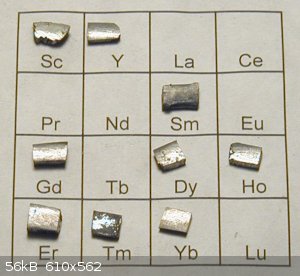
"Science is the belief in the ignorance of the experts" Richard Feynman
|
|
|
Brain&Force
Hazard to Lanthanides
    
Posts: 1302
Registered: 13-11-2013
Location: UW-Madison
Member Is Offline
Mood: Incommensurately modulated
|
|
Yeah, I've referenced that chart many times. I just haven't seen them up close and personal.
If the Sm was stringy, it may have been the increased surface area that allowed for accelerated corrosion.
At the end of the day, simulating atoms doesn't beat working with the real things...
|
|
|
IrC
International Hazard
    
Posts: 2710
Registered: 7-3-2005
Location: Eureka
Member Is Offline
Mood: Discovering
|
|
If his piece in the pic was stood up a closeup would reveal it's exactly as stringy as mine. Meaning lengthwise crevasses grooves, whatever you want
to call it exist all through down the length. If you grabbed the piece off his card in the pic above with pliers you could pull it apart several
strings at a time. Implying O2 can go far inside the chunk easily between the strings. Of all my Lanthanides this makes Sm by far the simplest to get
small pieces for experiments. You should try taking a small sample off a chunk of Gadolinium. Even with a good hacksaw it's work. That along with the
Fe contamination troubles I had is why I use a Dremel cutting wheel at high RPM now.
Look closely at this pic from wiki is easy to see what I mean:
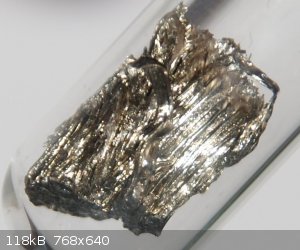
"Science is the belief in the ignorance of the experts" Richard Feynman
|
|
|
sbreheny
Hazard to Others
  
Posts: 145
Registered: 30-1-2014
Member Is Offline
Mood: No Mood
|
|
I will take more photos of the raw metal when I get a chance - maybe tomorrow. As I said earlier, I re-dissolved the crystals in pure water and let
that evaporate today. It is almost completely dry but I want to give it another day. The crystals do look very different now - I will get a photo of
them as soon as I can. I took the unmagnified photos of the raw metal and crystals under a compact fluorescent light. The magnified one is using my
microscope illuminator, which is white-LED based.
|
|
|
IrC
International Hazard
    
Posts: 2710
Registered: 7-3-2005
Location: Eureka
Member Is Offline
Mood: Discovering
|
|
I think POK has the answer when he was talking about the state of hydration concerning your difficulties.
"Science is the belief in the ignorance of the experts" Richard Feynman
|
|
|
Pok
potassium Prometheus
  
Posts: 176
Registered: 5-12-2010
Member Is Offline
|
|
Samarium, Europium and Scandium for example can show such a golden oxide layer. Of course, you can exclude at least Eu (too reactive) and Sc
(too expensive).
Quote: Originally posted by IrC  | | If his piece in the pic was stood up a closeup would reveal it's exactly as stringy as mine. Meaning lengthwise crevasses grooves, whatever you want
to call it exist all through down the length. |
The similarities you talk about can be explained by the preparation method of the metals and their degree of surface oxidation. The "stringy" looking
metal is simply a result of destillation. All RE metals show this structure when prepared by destillation afaik. And the golden colour is a result of
a more or less thick oxide layer. Remember steel with it's colour variation which can result from heating/oxidation. I think all RE metals can show
this structure and many can show a golden tint, depending on the degree of oxidation.
In general, the attempt to identify thulium only by some visible properties (colour of metal and salts, magnetic properties, etc.) will not be
sufficient. There are good reasons why analyses are made with expensive equipment in the case of RE metals (very similar chemical behaviour).
Especially the purity isn't easy to determine. But I think that business sellers usually don't cheat you (except for purities).
|
|
|
Brain&Force
Hazard to Lanthanides
    
Posts: 1302
Registered: 13-11-2013
Location: UW-Madison
Member Is Offline
Mood: Incommensurately modulated
|
|
Can you make some thulium chloride? It should be pretty intensely green compared to the sulfate.
At the end of the day, simulating atoms doesn't beat working with the real things...
|
|
|
Pok
potassium Prometheus
  
Posts: 176
Registered: 5-12-2010
Member Is Offline
|
|
Why? Only the cation makes the colour.
This is how the chloride looks like. Very faint green, comparable to the sulfate. But there the crystals are smaller than my sulfate crystals,
which may explain the weaker colouration.
[Edited on 1-7-2014 by Pok]
|
|
|
Brain&Force
Hazard to Lanthanides
    
Posts: 1302
Registered: 13-11-2013
Location: UW-Madison
Member Is Offline
Mood: Incommensurately modulated
|
|
I'm not sure what it is - might be some sort of a complex forming between chloride and thulium (probably a cationic one).
The anion does have an effect on the color of salts, especially colorful rare earth salts. See woelen's work on neodymium salts - the nitrate is less
pinkish and more of a lavender color.
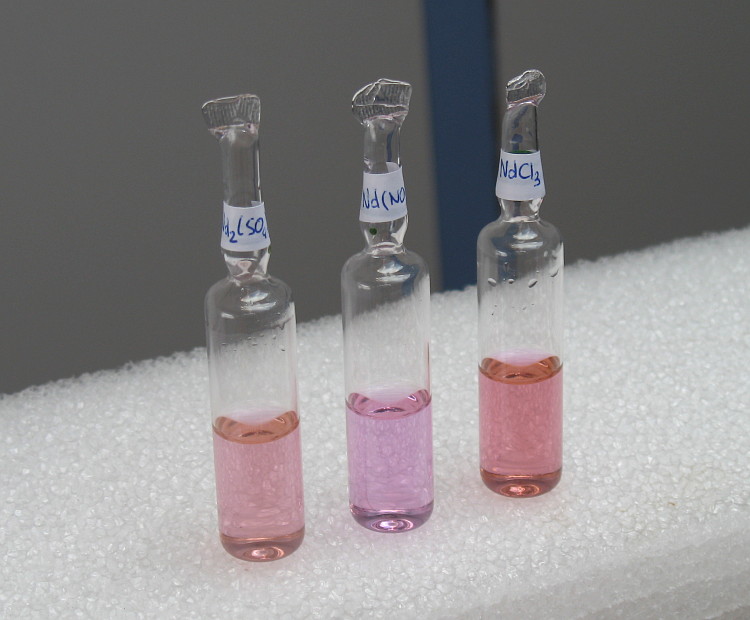
The one on the left is also neodymium chloride, but dissolved in excess HCl. Notice the difference in color:
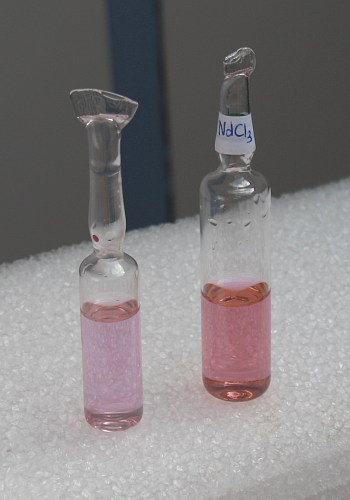
http://woelen.homescience.net/science/chem/exps/neodymium/in...
At the end of the day, simulating atoms doesn't beat working with the real things...
|
|
|
Pok
potassium Prometheus
  
Posts: 176
Registered: 5-12-2010
Member Is Offline
|
|
These are examples of dissolved ions with excess of acid in solution. In this case complex formation can result. But I don't think that this can
happen in the solid crystal. Maybe parts of water of crystallization can be replaced by acid molecules and form a solid complex in this way. I didn't
notice a strong dependence of thulium(III) colour from the light source as in the case of neodymium ions. I will make some tests with thulium oxide
and different HCl concentrations tomorrow.
|
|
|
Brain&Force
Hazard to Lanthanides
    
Posts: 1302
Registered: 13-11-2013
Location: UW-Madison
Member Is Offline
Mood: Incommensurately modulated
|
|
Terbium does form a hexaaquadichloro complex (which is highly triboluminescent). Unfortunately, terbium compounds are all white, so there's no
significant color change.
Wow, this is my 20th post today.
At the end of the day, simulating atoms doesn't beat working with the real things...
|
|
|
sbreheny
Hazard to Others
  
Posts: 145
Registered: 30-1-2014
Member Is Offline
Mood: No Mood
|
|
OK, here are the additional photos.
Naturally-dried crystals
Crystal Habit (magnified)
Raw metal, side A
Raw metal, side A, magnified
Raw metal, side B
Raw metal, side B magnified
Raw metal, edge, magnified
I will probably try making other salts of this to see if they have a different appearance. I can readily make the chloride, bromide, and nitrate.
I also bought a small Thulium sample from Metallium to compare. It has not yet arrived.
Finally, as suggested, I will try testing the acid for iron. I am waiting for some KSCN to arrive.
Thanks for the help and interest!
|
|
|
sbreheny
Hazard to Others
  
Posts: 145
Registered: 30-1-2014
Member Is Offline
Mood: No Mood
|
|
By the way - when I do the Thiocyanate test on the acid, I will dilute it first to prevent HCN formation. I believe that it is not likely given that
this is the SCN ion and not CN, but I have read that if you combine KSCN with a strong acid and heat, you may get HCN.
|
|
|
IrC
International Hazard
    
Posts: 2710
Registered: 7-3-2005
Location: Eureka
Member Is Offline
Mood: Discovering
|
|
Here is one of my 5 gm pieces of Thulium.
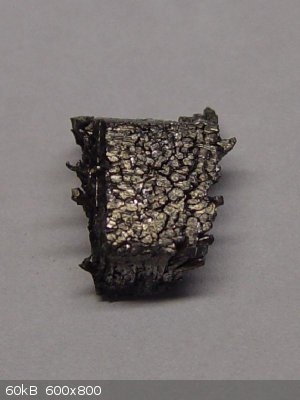 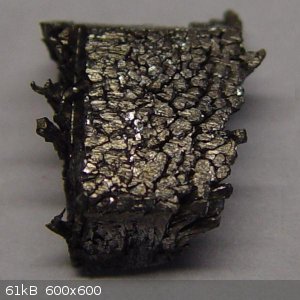 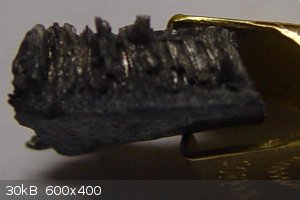
Best I can do, I sent my entire set of 58 mm closeup and macro lenses to a family member who is studying photography. I knew I should have kept at
least one around for just such a need as this thread. Lighting is typical dual 4 foot florescent tubes with camera flash turned off.
"Science is the belief in the ignorance of the experts" Richard Feynman
|
|
|
| Pages:
1
2
3
4 |